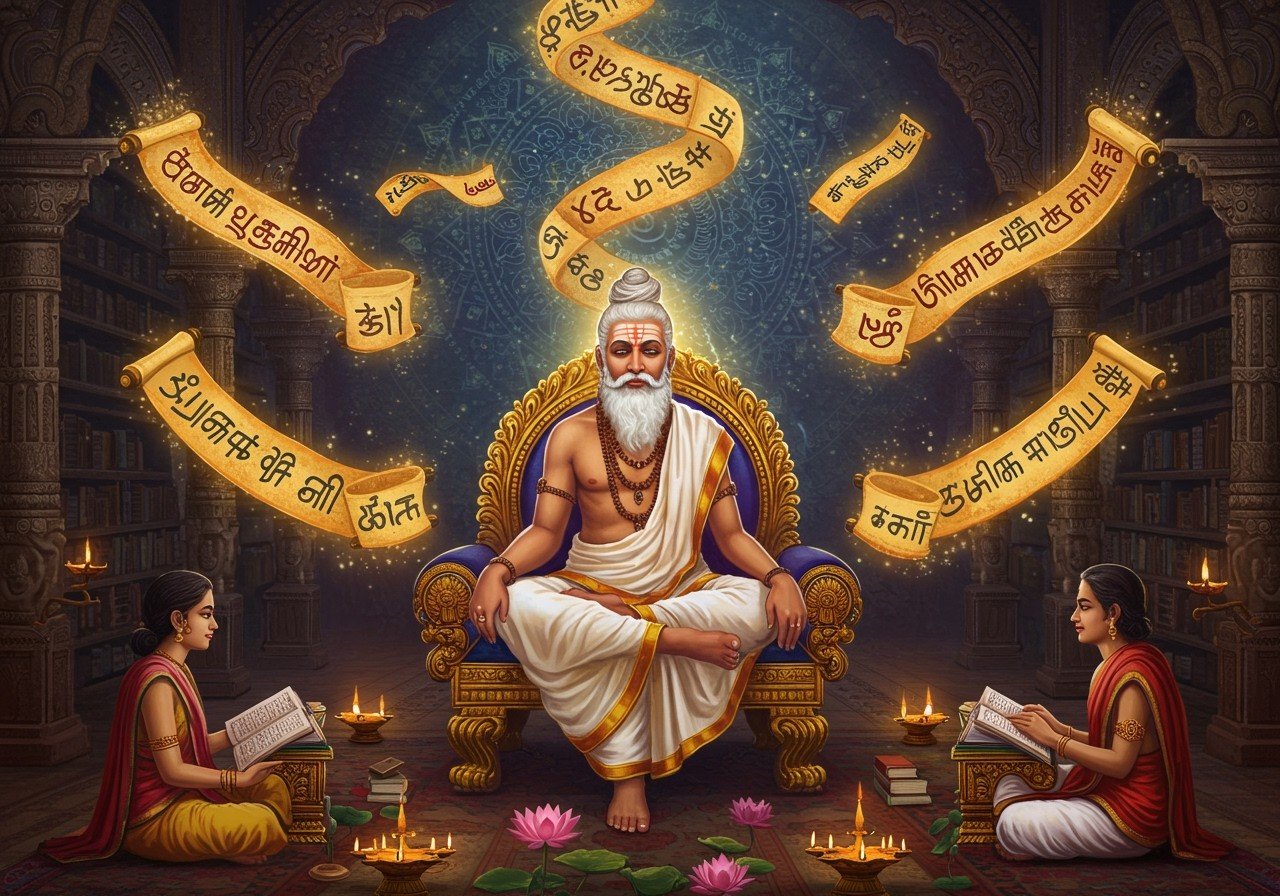
The Thirukkural, a cherished Tamil classic penned by the poet Thiruvalluvar, radiates wisdom on various facets of life. It acts as a universal compass for morality, ethics, and leading a virtuous life. Structured into 1330 couplets (kurals) across three sections – virtue (aram), wealth (porul), and love (inbam) – the Kural’s timeless relevance resonates with diverse readers across cultures and languages. This exploration delves into the translations and interpretations of the Kural, focusing on English, Tamil, and Hindi, offering a glimpse into its profound impact on global audiences.
The Original Kural in Tamil
Thiruvalluvar’s masterpiece, the Thirukkural, is originally composed in Tamil, celebrated for its poetic brilliance and elegance. It reflects the socio-political landscape of ancient Tamil Nadu, offering a window into the past. This text holds remarkable philosophical depth and explores universal themes that continue to hold significance in our modern world. Key Tamil terms and concepts in the Kural, such as “Aram” (virtue), “Porul” (wealth or material prosperity), and “Inbam” (love or happiness), present unique challenges to translators who strive to maintain the original’s poetic form and meaning. The essence of these concepts needs to be conveyed accurately while respecting the cultural nuances embedded within them.
The Kural in English
The journey of Thirukkural translations into English commenced in the 19th century. Pioneering translators like G.U. Pope, whose 1886 translation is widely acclaimed, played a pivotal role in introducing the Kural to English-speaking audiences. These translations, however, vary in style and interpretation, potentially influencing how readers perceive the text. Specific couplets may have different interpretations based on the translator’s choices, impacting the overall understanding. Cultural nuances can be either lost or painstakingly preserved in English versions, affecting how non-Tamil speaking audiences receive the text’s wisdom.
For those seeking deeper understanding of Lord Venkateswara, Poojn.in offers a wealth of resources and products for your spiritual journey. Learn more about Kalyana Venkateswara and how to perform puja at home.
The Kural in Hindi
The translation of the Thirukkural into Hindi has found a welcoming reception among Hindi-speaking audiences, opening doors to Tamil literature and philosophy. Yet, translators encounter significant challenges in conveying the essence of Tamil philosophical thought in Hindi due to cultural and linguistic differences that can influence interpretation. Certain key concepts may differ between the Tamil and Hindi versions, as observed in specific couplets. Hindi translations play a vital role in fostering inter-regional understanding and appreciation of Tamil literary traditions.
Enhance your spiritual practice with authentic puja items from Poojn.in. We offer a wide range of high-quality products, like brass tortoises and brass doob grass, to elevate your puja experience. You can also find pure ashtagandha kumkum for tilak, adding a touch of tradition to your rituals.
A Comparative Look at Translations
A comparative analysis of Thirukkural translations across English, Tamil, and Hindi reveals fascinating variations in specific couplets. These differences often stem from the cultural contexts that influence interpretation and reader reception. The delicate task of translating the Kural involves striking a balance between remaining faithful to the original text while ensuring accessibility for diverse audiences. Footnotes and commentary provided by translators often serve as valuable guides, illuminating complex concepts and shedding light on nuanced meanings.
Thirukkural’s Global Impact Through Translations
Translations of the Thirukkural have profoundly impacted global audiences, particularly in regions where Tamil isn’t widely spoken. These translations facilitate cross-cultural dialogue and foster greater understanding between different communities. They stimulate ethical discourse in non-Tamil communities and enrich academic studies in literature and ethics worldwide. Digital platforms and online resources now offer unprecedented opportunities for the further dissemination of the Kural’s wisdom.
Delve into the world of Thirukkural translations and experience its timeless teachings across linguistic boundaries. Each version offers a unique lens into the profound wisdom of Thiruvalluvar’s work. You can explore more about the significance of Kalyana Venkateswara Temple and seeking divine blessings through Prasanna Venkateswara on Poojn.in. Deepen your spiritual connection with genuine Tulsi malas and Tulsi Kanthi malas available at Poojn.in.
Frequently Asked Questions about the Thirukkural and its Translations
What exactly is the Thirukkural? The Thirukkural, often referred to as simply the Kural, is a classic Tamil text composed by Thiruvalluvar. It comprises 1,330 couplets, known as kurals, which offer profound insights into various aspects of life, including ethics, morality, and conduct. It’s a guide to living a fulfilling and virtuous life.
Why is the Thirukkural considered so important? The Thirukkural’s enduring importance stems from its timeless wisdom and practical guidance on leading a virtuous life. It delves into universal themes such as love, wealth, virtue, governance, and social ethics, offering valuable lessons that remain relevant even today.
Into how many languages has the Thirukkural been translated? The Thirukkural has been translated into numerous languages, reflecting its global appeal. Estimates vary, but it’s believed to be available in over 70 languages worldwide, including major Indian languages like Hindi, Kannada, Malayalam, Telugu, and Sanskrit, as well as many international languages. This widespread availability allows people from diverse linguistic backgrounds to access its wisdom.
Where can I find English translations of the Thirukkural? English translations of the Thirukkural are readily available. You can find them in various formats, including printed books, online platforms, and digital libraries. Many reputable publishers and websites offer versions with insightful commentary and explanations.
Is the original Thirukkural written in Tamil? Yes, the original Thirukkural was composed in Tamil. It stands as one of the oldest and most revered texts in Tamil literature, representing a cornerstone of Tamil cultural heritage.
Are there Hindi translations of the Thirukkural available? Yes, the Thirukkural is accessible in Hindi through various translations. These translations aim to convey the essence and wisdom of the original Tamil verses to Hindi-speaking audiences, bridging linguistic and cultural gaps.
What are some of the key challenges involved in translating the Thirukkural? Translating the Thirukkural presents significant linguistic and cultural challenges. Capturing the depth and nuances of the original couplets while preserving their poetic form, concise structure, and intended meaning requires careful consideration. Finding equivalent expressions in other languages that effectively convey the cultural context and philosophical concepts can be particularly demanding.
Why is it beneficial to explore the Thirukkural in different languages? Exploring the Thirukkural in different languages provides a broader perspective on its timeless wisdom. Each language and translation offers unique insights and interpretations, allowing readers to appreciate the text’s depth and relevance from various cultural viewpoints. It also fosters cross-cultural understanding and appreciation of Tamil literature.


